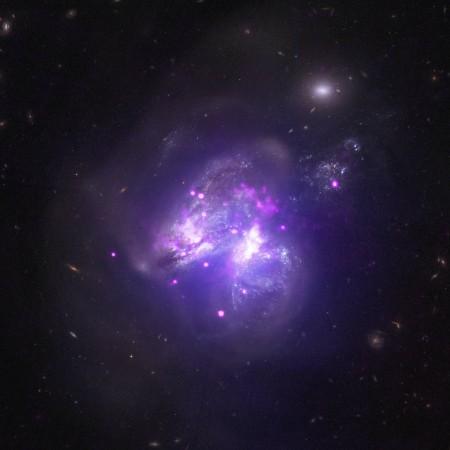
A new image from NASA's Chandra X-ray Observatory reveals what happens when you take two galaxies and mix them together over millions of years. The new data about a system dubbed Arp 299 showed 25 bright X-ray sources scattered throughout the system, according to a NASA statement. Located 140 million light years from Earth, the system comprises two merging galaxies, which form a partially blended mix of stars from each galaxy.
Also Read: NASA's IRIS helped in solving the mystery behind Sun's spicules [VIDEO]
It was found that 14 of these sources were strong emitters of X-ray, which are classified as "ultra-luminous X-ray sources," or ULXs.
These ULXs are most likely a binary system in which a neutron star or black hole is pulling matter away from a companion star that is much more massive than the Sun. These double star systems are called high-mass X-ray binaries. The ULXs were spotted in the regions where stars were forming at a speedy rate.
Such a loaded buffet of high-mass X-ray binaries is rare, but Arp 299 is one of the most powerful star-forming galaxies. This is due at least in part to the merger of the two galaxies, which has triggered waves of star formation. The formation of high-mass X-ray binaries is a natural consequence of such blossoming star births as some of the young massive stars, which often form in pairs, evolve into these systems, according to a NASA statement.
This new composite image of Arp 299 contains X-ray data from Chandra (pink), higher-energy X-ray data from NuSTAR (purple), and optical data from the Hubble Space Telescope (white and faint brown). Arp 299 also emits copious amounts of infrared light that has been detected by observatories such as NASA's Spitzer Space Telescope, but those data are not included in this composite.
The infrared and X-ray emission of the galaxy is remarkably similar to that of galaxies found in the very distant Universe, offering an opportunity to study a relatively nearby analog of these distant objects. A higher rate of galaxy collisions occurred when the universe was young, but these objects are difficult to study directly because they are located at colossal distances.
The Chandra data also reveal diffuse X-ray emission from hot gas distributed throughout Scientists think the high rate of supernovas, another common trait of star-forming galaxies, has expelled much of this hot gas out of the centre of the system.
The Chandra X-ray Observatory was launched in 1999, and it is now in orbit around the Earth. The Chandra Observatory is a telescope specially designed to detect X-ray emissions from very hot regions of the universe.









!['Had denied Housefull franchise as they wanted me to wear a bikini': Tia Bajpai on turning down bold scripts [Exclusive]](https://data1.ibtimes.co.in/en/full/806605/had-denied-housefull-franchise-they-wanted-me-wear-bikini-tia-bajpai-turning-down-bold.png?w=220&h=138)



